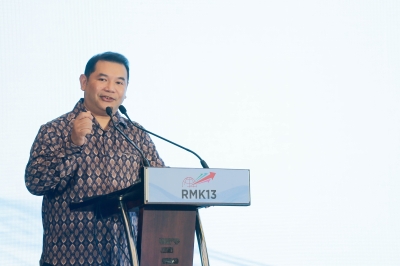KUALA LUMPUR, Sept 5 — The 13th Malaysia Plan (RMK-13), set to be implemented from 2026 to 2030, is Malaysia’s ambitious roadmap to navigate the country through a rapidly changing global landscape while addressing pressing domestic challenges.
Building on the economic Madani framework, RMK-13 aims to propel Malaysia to the forefront of Asian economies while enhancing the quality of life for its people.
What is RMK-13?
Global challenges and local realities
RMK-13 emerges against a backdrop of global uncertainty. Factors such as geopolitical tensions, rising public and private debt and a fragmented global economy contribute to the complexity and unpredictability of the international landscape.
These global shifts demand that Malaysia adapt its economic strategies to remain competitive.
Global outlook:
- Global economy expected to grow at an average of 2.5 per cent annually from 2024 to 2050
- Economic power shifting towards East and South
- Rising public and private debt levels in developed nations
- Tight monetary policies adding new pressures
Malaysia outlook:
- Projected GDP growth of 3.6 per cent annually
- GDP forecast to increase from RM1.6 trillion in 2024 to RM4.1 trillion by 2050
- Expected improvement in household incomes
- Potential financial challenges due to global debt levels
Malaysia’s local landscape
Domestically, Malaysia faces structural challenges such as slow economic transitions, a shortage of skilled workers, and an uncompetitive labour market.
Additional issues include rising living costs, socio-economic inequality and regional imbalances in development.
RMK-13 will tackle these problems through targeted reforms, improving governance and advancing high-impact sectors like green technology and digital innovation.
Transformative focus areas
At the heart of RMK-13 is a commitment to addressing four key megatrends that will shape the future:
- Shifts in economic blocs: As new economic powers rise in Asia, Malaysia must recalibrate its strategies to seize opportunities in trade and investment. For instance, household income is expected to improve alongside GDP growth, but increased debt due to tight monetary policies in developed nations presents a challenge.
- Technological and digital evolution: With advancements in AI, big data, and robotics, RMK-13 aims to close the technology gap between Malaysia and developed nations. By investing heavily in research, innovation, and digital infrastructure, the country plans to keep pace with global technological advancements.
- Demographic and quality of life shifts: By 2044, 20 per cent of Malaysia’s population will be over 65 years old. RMK-13 will address the needs of an ageing population while ensuring younger generations have access to quality education, healthcare, and economic opportunities.
- Environmental and climate crisis: The climate crisis demands urgent action. RMK-13 incorporates sustainable practices to meet Malaysia’s renewable energy and climate goals, including efforts to mitigate biodiversity loss, manage climate risks, and reduce greenhouse gas emissions.
Aiming for sustainability and inclusivity
Sustainability and inclusivity are central to RMK-13’s agenda. The plan prioritises green growth, transitioning to renewable energy, and bolstering food security.
For example, one target is to increase food production by 60 per cent while reducing carbon emissions by 50 per cent by 2050.
RMK-13 also aims to improve public welfare by ensuring access to affordable housing, universal healthcare, and social protection. These initiatives are intended to reduce income inequality and provide a safety net for vulnerable populations.
Harnessing Malaysia’s strengths
Malaysia’s strategic focus under RMK-13 will leverage its position as a global hub for Islamic finance while pushing for digital innovation and high-value industries.
The plan emphasises empowering small and medium-sized enterprises (SMEs) and promoting regional growth to ensure prosperity is shared across the country.
Reforms in labour markets, fiscal policies, healthcare, and education are also key elements of the plan. For instance, the government plans to enhance the Technical and Vocational Education and Training (TVET) system to produce a highly skilled workforce essential for high-tech industries.
A vision for 2040 and beyond
RMK-13 is not just a short-term solution but a step toward Malaysia’s long-term development vision.
Aspirations for 2040 include creating a productive, innovative society with enhanced living standards and a sustainable environment.
The plan promotes green technology and advanced manufacturing to build a more resilient economy capable of weathering future crises.
Priorities and focus under RMK-13
- 1. Labour market reforms
- 2. Fiscal reforms
- 3. Education reforms
- 4. Health reforms
- 5. Green economy
- 6. Silver economy
- 7. Strategic high-value industries
- 8. Blue economy
- 9. Public transport
- 10. Regional balance
- 11. Progressive society
- 12. Housing reforms
- 13. Environmental health
- 14. Engagement with the third sector
- 15. Financing for growth
- 16. Public sector efficiency
Collaboration and Madani Mendengar
The success of RMK-13 relies on collaboration between the government, industry, and the public.
To gather input, Minister of Economy Rafizi Ramli introduced “Madani Mendengar” (Madani Listens), a series of public consultations designed to gather feedback from across the country.
This initiative will involve engagement sessions and focus groups in all 13 states, bringing together public thinkers, private sector representatives, and everyday people.

